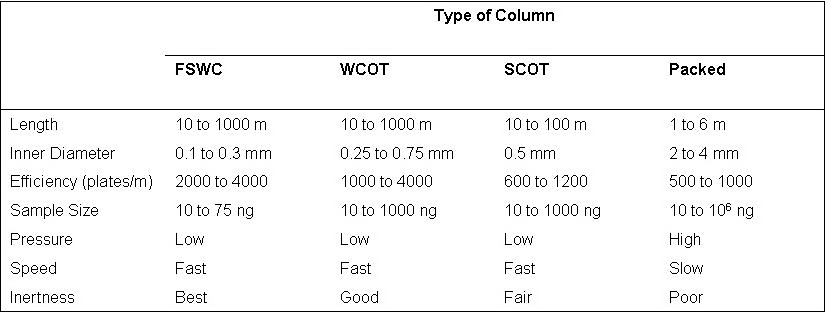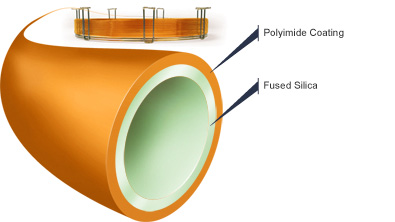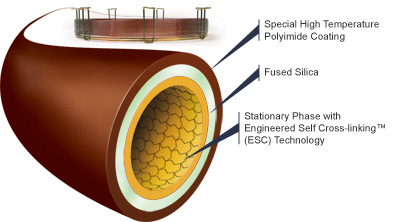
Open Tubular Columns and Packed Columns
 المؤلف:
LibreTexts Project
المؤلف:
LibreTexts Project
 المصدر:
................
المصدر:
................
 الجزء والصفحة:
.................
الجزء والصفحة:
.................
 4-2-2020
4-2-2020
 3359
3359
Open Tubular Columns and Packed Columns
Open tubular columns, which are also known as capillary columns, come in two basic forms. The first is a wall-coated open tubular (WCOT) column and the second type is a support-coated open tubular (SCOT) column. WCOT columns are capillary tubes that have a thin later of the stationary phase coated along the column walls. In SCOT columns, the column walls are first coated with a thin layer (about 30 micrometers thick) of adsorbant solid, such as diatomaceous earth, a material which consists of single-celled, sea-plant skeletons. The adsorbant solid is then treated with the liquid stationary phase. While SCOT columns are capable of holding a greater volume of stationary phase than a WCOT column due to its greater sample capacity, WCOT columns still have greater column efficiencies.
Most modern WCOT columns are made of glass, but T316 stainless steel, aluminum, copper and plastics have also been used. Each material has its own relative merits depending upon the application. Glass WCOT columns have the distinct advantage of chemical etching, which is usually achieved by gaseous or concentrated hydrochloric acid treatment. The etching process gives the glass a rough surface and allows the bonded stationary phase to adhere more tightly to the column surface.
One of the most popular types of capillary columns is a special WCOT column called the fused-silica wall-coated (FSWC) open tubular column. The walls of the fused-silica columns are drawn from purified silica containing minimal metal oxides. These columns are much thinner than glass columns, with diameters as small as 0.1 mm and lengths as long as 100 m. To protect the column, a polyimide coating is applied to the outside of the tubing and bent into coils to fit inside the thermostatted oven of the gas chromatography unit. The FSWC columns are commercially available and currently replacing older columns due to increased chemical inertness, greater column efficiency and smaller sampling size requirements. It is possible to achieve up to 400,000 theoretical plates with a 100 m WCOT column, yet the world record for the largest number of theoretical plates is over 2 million plates for 1.3 km section of column.
Packed columns are made of a glass or a metal tubing which is densely packed with a solid support like diatomaceous earth. Due to the difficulty of packing the tubing uniformly, these types of columns have a larger diameter than open tubular columns and have a limited range of length. As a result, packed columns can only achieve about 50% of the efficiency of a comparable WCOT column. Furthermore, the diatomaceous earth packing is deactivated over time due to the semi-permanent adsorption of impurities within the column. In contrast, FSWC open tubular columns are manufactured to be virtually free of these adsorption problems.

Figure 1. Properties of gas chromatography columns.

Figure 2. Computer Generated Image of a FSWC column (specialized for measuring BAC levels)

Figure 3. Computer Generated Image of a FSWC column (specialized to withstand extreme heat)
Different types of columns can be applied for different fields. Depending on the type of sample, some GC columns are better than the others. For example, the FSWC column shown in Figure 2 is designed specially for blood alcohol analysis. It produces fast run times with baseline resolution of key components in under 3 minutes. Moreover, it displays enhanced resolutions of ethanol and acetone peaks, which helps with determining the BAC levels. This particular column is known as Zebron-BAC and it made with polyimide coating on the outside and the inner layer is made of fused silica and the inner diameter ranges from .18 mm to .25 mm. There are also many other Zebron brand columns designed for other purposes.
Another example of a Zebron GC column is known as the Zebron-inferno. Its outer layer is coated with a special type of polyimide that is designed to withstand high temperatures. As shown in Figure 3, it contains an extra layer inside. It can withstand up to 430 °C to be exact and it is designed to provide true boiling point separation of hydrocarbons distillation methods. Moreover, it is also used for acidic and basic samples.
 الاكثر قراءة في التحليل الآلي (الطيفي)
الاكثر قراءة في التحليل الآلي (الطيفي)
 اخر الاخبار
اخر الاخبار
اخبار العتبة العباسية المقدسة


